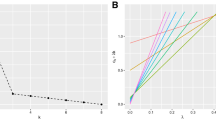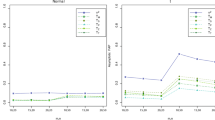Abstract
Suppose y, a d-dimensional (d ≥ 1) vector, is drawn from a mixture of k (k ≥ 2) populations, given by ∏1, ∏2,…,∏ k . We wish to identify the population that is the most likely source of the point y. To solve this classification problem many classification rules have been proposed in the literature. In this study, a new nonparametric classifier based on the transvariation probabilities of data depth is proposed. We compare the performance of the newly proposed nonparametric classifier with classical and maximum depth classifiers using some benchmark and simulated data sets.
Similar content being viewed by others
References
CHRISTMANN, A., and ROUSSEEUW, P. (2001), “Measuring Overlap in Binary Regression,” Computational Statistics and Data Analysis, 37, 65–75.
CHRISTMANN, A., FISCHER, P., and JOACHIMS, T. (2002), “Comparison Between Various Regression Depth Methods and the Support Vector Machine to Approximate the Minimum Number of Misclassifications,” Computational Statistics, 17, 273–287.
DONOHO, D. (1982), “Breakdown Properties of Multivariate Location Estimators,” PhD qualifying paper, Department of Statistics, Harvard University.
DONOHO, D., and GASKO, M. (1992), “Breakdown Properties of Location Estimates Based on Halfspace Depth and Projected Outlyingness,” Annals of Statistics, 20, 1803–1827.
EDDY, W.F. (1985), “Ordering of Multivariate Data,” in Computer Science and Statistics: The Interface, ed. L. Billard, Amsterdam: North-Holland, pp. 25–30.
FISHER, R.A. (1936), “The Use of Multiple Measurements in Taxonomic Problems,” Annals of Eugenics, 7, 179–188.
GHOSH, A.K. and CHAUDHURI, P. (2005), “On Maximum Depth and Related Classifiers,” Scandinavian Journal of Statistics, 32, 327–350.
GINI, C. (1916), “Il Concetto di Transvariazione e le sue Prime Applicazioni,” Giornale Degli Economisti and Rivista di Statistica, 52, 13–43.
HARDY, A. (1991), “On Tests Concerning the Existence of a Classification,” Belgian Journal of Operations Research, Statistics and Computer Sciences, 31, 111–126.
HUBERT, M., and VAN DRIESSEN, K. (2004), “Fast and Robust Discriminant Analysis,” Computational Statistics and Data Analysis, 45, 301–320.
JOHNSON, R.A., and WICHERN, D.W. (2002), Applied Multivariate Statistical Analysis, New Jersey: Prentice Hall.
JÖRNSTEN, R. (2004), “Clustering and Classification Based on the L1 Data Depth,” Journal of Multivariate Analysis, 90, 67–89.
LACHENBRUCH, P.A. (1975), Discriminant Analysis, New York: Hafner Press.
LIU, R. (1990), “On Notion of Data Depth-Based on Random Simplices,” Annals of Statistics, 18, 405–414.
LIU, R. (1992), “Data Depth and Multivariate Rank Tests,” in L 1 -statistical Analysis and Related Methods (Neuchâtel, 1992), ed. Y. Dodge, Amsterdam: North-Holland, pp. 279–294.
LIU, R., PARELIUS, J., and SINGH, K. (1999), “Multivariate Analysis of the Data Depth: Descriptive Statistics and Inference,” Annals of Statistics, 27, 783–858.
LIU, R., and SINGH, K. (1993), “A Quality Index Based on Data Depth and Multivariate Rank Tests,” Journal of the American Statistical Association, 88, 252–260.
LIU, R., and SINGH, K. (2006), “Rank Tests for Multivariate Scale Difference Based on Data Depth,” in Data Depth: Robust Multivariate Analysis, Computational Geometry and Applications, eds. R. Liu, R. Serfling, and D. Souvaine, DIMACS: Series in Discrete Mathematics and Theoretical Computer Science, 72, 17–36.
MAHALANOBIS, P.C. (1936), “On the Generalized Distance in Statistics,” Proceedings of the National Institute of Science of India, 12, 49–55.
MONTANARI, A. (2004), “Linear Discriminant Analysis and Transvariation,” Journal of Classification, 21, 71–88.
MORRISON, D.F. (2005), Multivariate Statistical Methods (4th ed.), Belmont, CA: Thompson.
MOSLER, K. (2002), Multivariate Dispersions, Central Regions and Depth, New York: Springer-Verlag.
MOSLER, K. and HOBERG, R. (2006), “Data Analysis and Classification with the Zonoid Depth,” in Data Depth: Robust Multivariate Analysis, Computational Geometry and Applications, eds. R. Liu, R. Serfling, and D. Souvaine, DIMACS: Series in Discrete Mathematics and Theoretical Computer Science, 72, 49–59.
POSSE, C. (1992), “Projection Pursuit Discriminant Analysis for Two Groups,” Communications in Statistics - Theory & Methods, 21, 1–19.
SINGH, K. (1991), “A Notion of Majority Depth,” Technical Report, Department of Statistics, Rutgers University.
TUKEY, J. (1974), “Mathematics and the Picturing of Data”, Proceedings of the International Congress of Mathematicians, Canadian Mathematical Congress, Vancouver, 2, 523–531.
VARDI, Y., and ZHANG, C.H. (2000), “The Multivariate L1-Median and Associated Data Depth,” Proceedings of the National Academy of Sciences USA, 97, 1423–1426.
ZUO, Y., and SERFLING, R. (2000), “General Notions of Statistical Depth Function,” Annals of Statistics, 28, 461–482.
Author information
Authors and Affiliations
Corresponding author
Additional information
The authors thank the editor and referees for comments that led to an improvement of this paper. This work is partially supported by the National Science Foundation under Grant No. DMS-0604726.
Published online xx, xx, xxxx.
Rights and permissions
About this article
Cite this article
Billor, N., Abebe, A., Turkmen, A. et al. Classification Based on Depth Transvariations. J Classif 25, 249–260 (2008). https://doi.org/10.1007/s00357-008-9015-7
Published:
Issue Date:
DOI: https://doi.org/10.1007/s00357-008-9015-7




